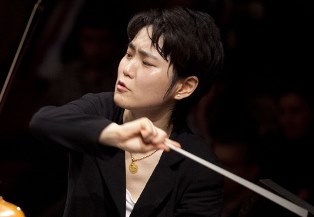
Chang Leads CSO in Sonic Splendor
Han-Na Chang’s last appearance with the Cincinnati
Symphony Orchestra was as a cellist in January, 2001.

She returned Friday morning at Music Hall, but this time she was on the podium, as CSO guest conductor.
It was a brilliant debut, one fully in keeping with Chang’s growing international reputation as a conductor. In works by Tchaikovsky and Mussorgsky, she kept her audience riveted, drawing a performance from the CSO that was rich in detail and sonic splendor. Guest artist was Dutch violinist Simone Lamsma, 28, in a return visit to the CSO, having made her debut with orchestra in April, 2013. Her calling card this time was the Violin Concerto by Benjamin Britten. Lamsma, too, fully met expectations, with a splendid performance of the Violin Concerto by Eric Wolfgang Korngold.
Chang, now 32, opened the concert with the Suite from Tchaikovsky’s ballet “The Sleeping Beauty” (surprisingly enough, in its CSO premiere, having previously been heard only on Young People’s, Parks and Pops concerts). The Introduction, “La Fée des lilas” (“The Lilac Fairy”), was exuberant, with Chang drawing a big sound from the orchestra. Principal harpist Gillian Benet Sella shone in the Adagio: Pas d’action, which opened with a harp cadenza before presenting another of the work’s familiar tunes. “Puss in Boots and The White Cat” featured sly portamento (sliding after notes) by oboe and English horn.
Panorama, a dreamy waltz, was followed by the waltz, i.e. the “Sleeping Beauty Waltz” (known as “Once Upon a Dream” in the Disney film), which concluded the Suite with flair.
Korngold’s 1945 Violin Concerto is shot through with Hollywood themes, Korngold’s own from the years he spent as one of the greatest of all film composers (indeed, he may be said to have invented the film score genre as it developed in the 1930s and 40s). Each movement of the Concerto draws from one of his film scores (two appear in the opening Moderato nobile). Any bias against Hollywood music – which tended to be snubbed by “serious” musicians in those days – has, of course, ended, and we can enjoy the work on its own terms. (It was premiered by violinist Jascha Heifetz in 1947.)
Lamsma displayed a pure, sweet tone in the first movement, a highly romantic one with a brief cadenza full of double-stops and lots of playing in the instrument’s highest register. (She continued her superb negotiation of the violin’s stratosphere throughout the Concerto.) The second movement, Romance: Andante, contained a brief muted section that was caressing in its beauty.
The Allegro Finale, a wonderful, spirited rondo, combined a rustic principal theme with lots of fireworks, all of which Lamsma filled with bounce and fervor. A special moment occurred when the violin engaged in a dialogue with the flute, whose skittering passages were projected with clarity and precision by associate principal flutist Henrik Heide.
Mussorgsky’s “Pictures at an Exhibition,” in the orchestration by Ravel, is one of the great orchestral showpieces, the kind of thing that 3,400-seat, acoustically welcoming Music Hall was built for. Its abundant color saturated the hall, painting vivid images for the numerous listeners at this matinee concert. The opening Promenade was brassy and sparkling. “Gnomus” was as spooky as could be desired. The CSO woodwinds, joined by James Bunte on alto saxophone, crafted an evocative “”Il Vecchio Castello” (“The Old Castle”), while “Tuileries” was pure fun and games. Cristian Ganicenco on tenor tuba gave substance to the staunch tread of “Bydlo,” while the woodwinds frolicked merrily in the “Ballet of the Unhatched Chicks.”
Principal trumpet Matthew Ernst made easy work of the trumpet’s difficult figures in “Samuel Goldenberg and Schmuyle.” “Limoges” (“The Market”) was a frantic chase by the full orchestra. “Catacombs,” which followed without a break, plunged suddenly into the dark and foreboding. “The Little House on Chicken’s Legs” (home of the witch Baba Yaga in Russian fairy tales) was full and rich, leading seamlessly into the final “Great Gate of Kiev” (which was never built, by the way, though this writer has seen where it was supposed to be in Ukraine’s capital city).
Chang let the “Great Gate” unfold splendidly, with its contrasts of loud and soft and grand chorale near the end. She unleashed the percussion in the final bars, chime, tam-tam, cymbals and all, for a magnificent conclusion, which brought the audience to its feet.
The concert repeats at 8 p.m. Saturday at Music Hall. Tickets begin at $12. Call (513) 381-3300, or visit www.cincinnatisymphony.org